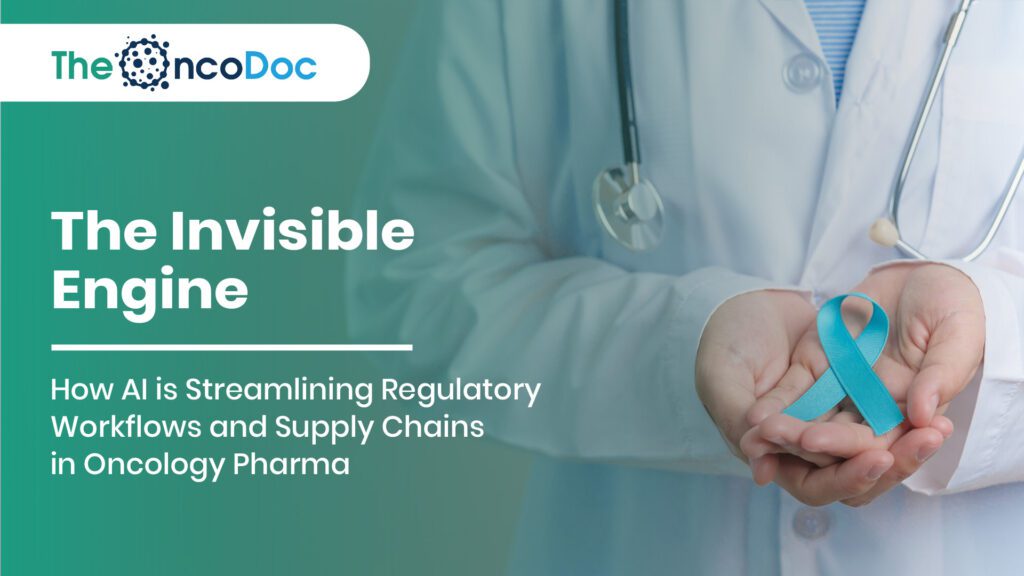Introduction: The Hidden Backbone of Oncology Pharma
In the world of oncology pharma, breakthroughs in immunotherapies, precision medicine, and AI-powered diagnostics capture headlines. Yet, beneath this visible layer of innovation lies an equally critical but often overlooked backbone, the regulatory workflows and supply chains that ensure life-saving treatments reach patients safely, compliantly, and on time.
AI is increasingly stepping into this invisible engine room, automating the most complex and resource-intensive processes. From regulatory submissions to inventory management, from compliance monitoring to predictive logistics, AI is turning fragile back-end systems into resilient, intelligent ecosystems.
This article explores how AI is transforming oncology pharma operations behind the scenes, and why this silent revolution is central to accelerating patient access, reducing risks, and reshaping marketing strategies in oncology.
1. Automated Document Creation and Submission
Regulatory submissions like Global Value Dossiers (GVDs) and marketing authorization files require enormous effort. AI-powered NLP and LLMs:
- Draft initial versions of complex documents.
- Extract trial data, real-world evidence, and scientific references with precision.
- Ensure consistency in terminology and structure across hundreds of pages.
This automation reduces manpower hours, speeds up time-to-submission, and enables marketers to shift focus from documentation to patient engagement strategies.
2. Real-Time Compliance Monitoring
Regulatory frameworks (FDA, EMA, CDSCO) evolve constantly. AI tools:
- Track regulatory updates globally in real time.
- Flag deviations in oncology trial protocols or marketing campaigns.
- Reduce costly delays due to non-compliance.
This builds trust and credibility, both with regulators and with healthcare professionals (HCPs).
3. Accelerating Clinical Trial Operations
Clinical trials in oncology are often delayed by slow recruitment and complex monitoring. AI helps overcome these challenges by:
- Patient Identification: Mining electronic health records (EHRs) to quickly locate eligible candidates.
- Automated Screening: Matching patients against inclusion and exclusion criteria with high accuracy.
- Real-Time Monitoring: Tracking patient data to detect adverse events early and ensure compliance.
These capabilities not only shorten trial timelines but also enhance safety, reduce costs, and improve data quality. Faster, more reliable trials boost brand reputation while ensuring patients gain earlier access to innovative therapies.
4. Predicting Regulatory Outcomes
By analyzing historical approval data, AI predicts approval likelihood for oncology drugs. Insights help companies:
- Prioritize drugs with higher approval probabilities.
- Refine clinical strategies early.
- Allocate marketing resources strategically.
This ensures optimized portfolio investments and smarter go-to-market planning.
5. AI-Powered Regulatory Intelligence for Marketers
Beyond compliance, AI-driven intelligence feeds marketing strategy:
- Identifying countries with faster regulatory clearance windows.
- Suggesting launch sequencing for maximum impact.
- Integrating compliance-readiness as a marketing differentiator.
Pharma brands can position themselves not only as innovators but also as regulatory leaders in oncology.

6. Predictive Demand Forecasting
One of the biggest challenges in oncology supply chains is aligning supply with unpredictable demand. AI solves this by applying advanced analytics to:
- Forecast Demand Accurately: Using patient demographics, evolving disease prevalence, and prescription behaviors.
- Leverage External Signals: Incorporating hospital utilization data, seasonal variations, and even social media health discussions.
- Optimize Inventory: Anticipating spikes or declines to maintain balanced stock levels.
This proactive approach reduces the risk of critical drug shortages, minimizes costly overstocking, and ensures patients consistently receive timely access to essential cancer therapies, enhancing both operational efficiency and brand credibility.
7. Inventory Management and Wastage Reduction
AI-driven systems optimize inventory at hospitals, pharmacies, and distribution centers by:
- Tracking drug shelf life and storage needs.
- Automatically redistributing near-expiry stock.
- Reducing waste for expensive oncology treatments.
This strengthens trust among HCPs and patients who rely on consistent drug availability.
8. Enhancing Visibility and Security with AI + Blockchain
High-value oncology drugs, particularly biologics, are vulnerable to counterfeiting and mishandling, making visibility and security critical. By combining AI with blockchain, pharma companies gain:
- End-to-End Transparency: Every movement of the drug is tracked and recorded immutably.
- Cold-Chain Monitoring: Real-time alerts ensure temperature-sensitive therapies remain stable during transit.
- Counterfeit Prevention: Verified digital tracking eliminates risks of fake products entering the system.
For marketing, this technology-backed assurance builds powerful patient and provider confidence, turning authenticity and safety into defining brand differentiators in an increasingly trust-driven oncology market.
9. Automated Logistics and Route Optimization
Efficient delivery is critical in oncology pharma, where delays can directly impact patient survival. AI-powered logistics systems transform last-mile delivery by continuously monitoring real-time variables such as traffic congestion, weather changes, and even geopolitical risks that may affect transport routes.
- Dynamic Routing: AI recommends the fastest, safest alternative routes instantly, minimizing delivery delays.
- Cold-Chain Integrity: Sensitive oncology drugs often require strict temperature controls. AI-enabled monitoring ensures these therapies maintain stability and arrive in perfect condition.
- Predictive Planning: Algorithms anticipate potential disruptions before they occur, allowing proactive adjustments in logistics scheduling.
By safeguarding timely and safe deliveries, pharma companies not only improve patient outcomes but also strengthen their reputation for reliability. Marketing teams can amplify this operational strength, positioning logistics resilience as a core brand promise and showcasing their commitment to ensuring life-saving treatments always reach patients when needed most.
10. Predictive Maintenance of Cold-Chain Equipment
AI-enabled IoT devices predict equipment failures before they occur.
- Refrigeration malfunctions can destroy oncology batches worth millions.
- Predictive AI reduces such risks by early detection.
By ensuring drug integrity, pharma brands reinforce their patient-safety promise.

11. Regulatory Speed as a Marketing Advantage
In oncology, regulatory approval timelines directly influence how quickly patients can benefit from breakthrough therapies. AI is transforming this space by automating submissions, reducing errors, and analyzing historical data to predict approval success rates. These capabilities enable faster clearances, allowing companies to enter markets earlier and make life-saving drugs accessible sooner. For pharma marketers, this speed becomes a compelling narrative that demonstrates both innovation and responsibility.
- Patient-Centric Messaging: Campaigns can emphasize reduced time-to-patient, reinforcing a brand’s commitment to delivering hope without unnecessary delays.
- Compliance Excellence: By showcasing real-time regulatory monitoring, companies highlight their reliability and transparency to healthcare professionals and regulators.
- Leadership Positioning: Oncology brands that leverage AI-driven speed can present themselves as pioneers, balancing efficiency with safety, and setting new benchmarks for industry best practices.
Faster approvals thus become not only a competitive edge but also a meaningful patient promise.
12. Supply Chain Resilience as Brand Equity
In oncology pharma, resilient supply chains are not just operational strengths but powerful brand assets. AI-driven visibility and optimization ensure uninterrupted access to critical drugs, transforming reliability into a marketing differentiator. Campaigns can frame this resilience as a promise of patient safety and trust.
- Slogan Example: “Always Accessible, Always Authentic” highlights dependability.
- B2B Impact: Hospitals and healthcare providers prefer partnerships with companies that guarantee consistent availability, reinforcing loyalty and credibility while positioning supply resilience as a cornerstone of long-term brand equity.
13. Linking AI Efficiency to Patient-Centric Value
AI’s role in regulatory and supply efficiency offers pharma marketers a unique opportunity to humanize operational gains by linking them directly to patient outcomes. Campaigns can emphasize how automation and predictive tools translate into quicker therapy access, positioning efficiency as a patient benefit rather than just a business advantage.
- Example: Highlighting “AI ensures your treatment reaches you without delay.”
- Survivor narratives paired with AI-driven impact data create authentic, trust-building messages that resonate with both patients and healthcare professionals, reinforcing patient-first brand values.
14. Hyperlocal Distribution Insights for Market Strategy
AI shows which regions need oncology drugs most urgently. Marketing teams can:
- Focus awareness campaigns in high-demand zones.
- Partner with NGOs and hospitals for regional rollouts.
This maximizes both impact and efficiency of oncology campaigns.
15. Future-Ready Compliance Marketing
In an era where misinformation spreads quickly, regulatory credibility is marketing gold. AI-enabled compliance becomes a patient reassurance message:
- “Our drugs meet the highest global standards, monitored in real-time by AI.”
Such positioning directly boosts brand trust and differentiation.

16. Efficiency and Cost Reduction
AI streamlines oncology pharma operations by reducing manual workloads, minimizing regulatory delays, and optimizing supply chain management. Automated systems enhance accuracy, accelerate submissions, and prevent costly wastage of sensitive oncology drugs. These efficiencies translate into lower operational expenses and faster patient access to therapies. Importantly, the savings generated are reinvested into impactful initiatives such as patient education, disease awareness, and community outreach. By turning cost reduction into value creation, AI ensures both business sustainability and stronger patient-centric outcomes.
17. Risk Mitigation and Safety
AI is transforming oncology pharma by proactively identifying risks before they escalate. Advanced algorithms can flag potential compliance issues, predict equipment malfunctions in cold-chain systems, and detect anomalies that may signal counterfeit drug infiltration. By continuously monitoring these critical areas, AI minimizes regulatory penalties, safeguards product integrity, and ensures uninterrupted patient access to life-saving therapies. For pharma brands, this means stronger reputational trust, while for patients, it guarantees safer, more reliable treatment delivery. Ultimately, AI serves as a shield that protects both companies and patients from unforeseen threats.
18. Accelerated Patient Access
AI is redefining patient access in oncology by removing traditional barriers that slow down the availability of innovative treatments. Faster regulatory submissions, powered by automation and predictive analytics, shorten approval timelines significantly. At the same time, AI-driven supply chain optimization ensures that therapies are delivered to hospitals and pharmacies with greater speed and reliability. This dual impact means patients receive critical medications earlier, improving survival rates and quality of life. For pharma brands, accelerated access becomes both a clinical advantage and a marketing differentiator, demonstrating their commitment to timely, patient-centered care.
19. Beyond the Molecule: Marketing AI’s Invisible Role
AI’s hidden contributions in regulatory workflows and supply chain optimization offer powerful opportunities for strategic storytelling in oncology marketing. While patients may not see these behind-the-scenes processes, their impact is tangible, faster approvals, reliable availability, and enhanced safety of therapies. Campaigns that spotlight this “invisible engine” can differentiate brands by emphasizing their commitment to efficiency, compliance, and patient-first reliability. By connecting unseen operational excellence with visible health outcomes, pharma companies can build deeper trust, showing that innovation is not only in molecules but also in how treatments reach patients seamlessly.
20. The Future of Oncology’s Invisible Engine
The next wave of oncology pharma operations will merge AI, blockchain, IoT, and digital twins into a unified ecosystem that redefines efficiency and trust.
- Predictive AI will flag compliance risks and safety concerns before they impact patients.
- Digital twins of supply chains will run simulations to anticipate and prevent disruptions.
- Blockchain with IoT will ensure authenticity, security, and real-time visibility.
Pharma marketing will increasingly highlight these invisible strengths, showcasing reliability and operational excellence as core brand values, alongside innovation in oncology treatments.
Conclusion
While oncology pharma often highlights breakthroughs in drug discovery and precision therapies, these innovations cannot create real impact without the support of seamless regulatory systems and resilient supply chains. The unseen foundation of compliance, logistics, and risk management determines whether life-saving drugs actually reach patients on time. This is where AI plays its transformative role, as the invisible engine that drives the industry forward. By automating regulatory submissions, predicting market demand, safeguarding supply chains, and preventing compliance failures, AI ensures that operational hurdles no longer delay access to critical oncology treatments.
For pharma marketers, this operational revolution is far more than an internal upgrade, it is a powerful narrative of trust, safety, and patient-first commitment. Campaigns that communicate how AI enables faster approvals, consistent availability, and secure delivery can resonate deeply with both healthcare professionals and patients. Such messaging not only differentiates brands in a crowded market but also reinforces their credibility as reliable healthcare partners.
Ultimately, the true impact of AI’s invisible engine is measured not in processes optimized, but in patient lives improved. By blending efficiency with empathy, pharma companies can accelerate access to therapies while strengthening the trust that defines the future of oncology care.
The Oncodoc team is a group of passionate healthcare and marketing professionals dedicated to delivering accurate, engaging, and impactful content. With expertise across medical research, digital strategy, and clinical communication, the team focuses on empowering healthcare professionals and patients alike. Through evidence-based insights and innovative storytelling, Hidoc aims to bridge the gap between medicine and digital engagement, promoting wellness and informed decision-making.



